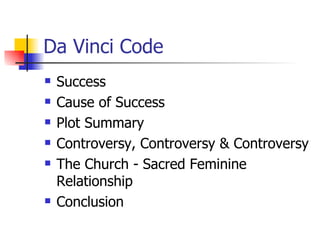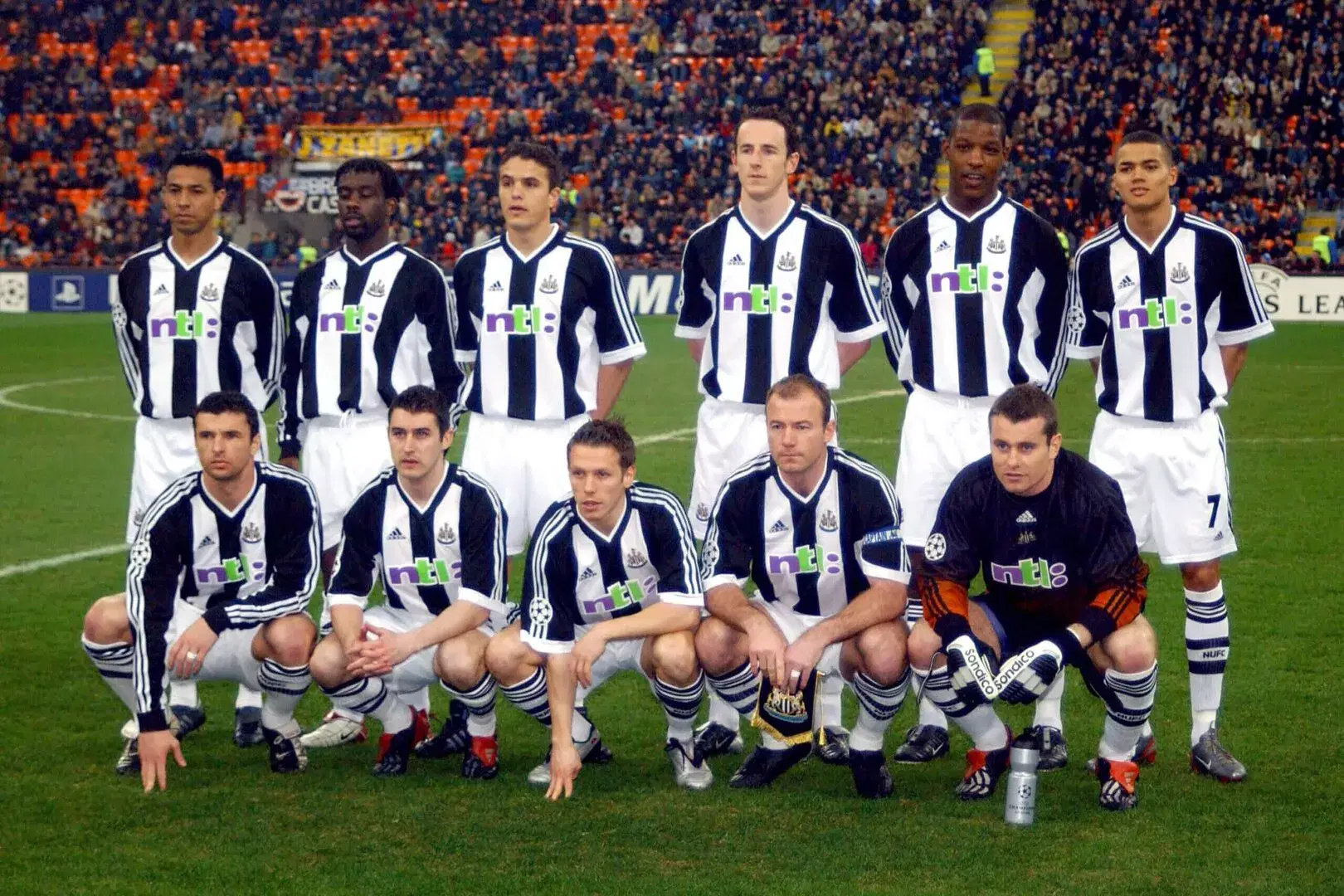Decoding The Da Vinci Code: Symbolism, History, And Controversy

Table of Contents
Unveiling the Symbolism of the Da Vinci Code
The Da Vinci Code is rich with symbolism, layering multiple meanings and interpretations onto its narrative. Understanding this symbolism is key to grasping the novel's central themes and appreciating its artistic merit.
The Sacred Feminine and the Suppression of Women's Roles
The novel presents a controversial reimagining of Mary Magdalene's role in early Christianity, portraying her not merely as a repentant sinner, but as Jesus's wife and the guardian of a sacred feminine lineage. This portrayal challenges traditional interpretations of biblical texts and highlights the potential suppression of women's roles in religious institutions.
- Mary Magdalene's portrayal: The Da Vinci Code suggests a deliberate historical cover-up to suppress the truth about Mary Magdalene's importance.
- Symbolic representation: The feminine principle is symbolically represented throughout the novel through various images and motifs, often connected to the earth, fertility, and spiritual power.
- Historical context: The novel draws attention to the limited roles available to women in early Christian communities and the broader historical context of patriarchal dominance.
- The Gnostic Gospels, with their emphasis on female figures, provide a counter-narrative that supports the Da Vinci Code's interpretation of Mary Magdalene's significance.
Decoding the Priory of Sion and its Alleged Secrets
The Priory of Sion, a real-life organization, is depicted in the novel as a secret society dedicated to protecting the secret bloodline of Jesus and Mary Magdalene. While the real Priory of Sion existed, its history is far less dramatic than the fictional version presented in the novel.
- Real-life Priory of Sion: The historical Priory of Sion was a relatively obscure organization with a less-than-secret history.
- Fictional portrayal: The novel dramatically expands upon the Priory's role, transforming it into a central player in a centuries-long conspiracy.
- Conspiracy as narrative device: The use of secret societies and conspiracies effectively creates suspense and intrigue, driving the narrative forward. The mystery surrounding the Priory of Sion is a key element of the Da Vinci Code's appeal.
Interpreting the Significance of Key Symbols and Imagery
The Da Vinci Code employs a range of symbols and imagery to enrich its narrative and convey its themes. These symbols are not randomly chosen; they carry specific meanings within the context of the novel and often have rich historical associations.
- The rose: Often symbolizes secrecy, beauty, and the sacred feminine.
- The Holy Grail: Represents both a physical and spiritual quest, often linked to the feminine principle and divine knowledge.
- The Fibonacci sequence: A mathematical sequence appearing in nature, suggesting divine order and a hidden pattern underlying reality.
- Symbolism in art: The novel uses Da Vinci's paintings as a source of clues, integrating artistic symbolism into the narrative.
Examining the Historical Accuracy (or Inaccuracy) of the Da Vinci Code
While the Da Vinci Code is a work of fiction, it draws extensively on historical events and figures, often presenting them in a controversial light. It's crucial to distinguish between factual accounts and the novel's creative liberties.
Fact vs. Fiction: Separating Truth from Artistic License
The novel takes significant liberties with historical facts to serve its narrative, leading to numerous inaccuracies and embellishments. While it sparks interest in history, readers must critically assess the information presented.
- Historical inaccuracies: Many historical details are either misinterpreted, exaggerated, or entirely fabricated.
- Narrative effect: The novel prioritizes a compelling narrative over strict historical accuracy.
- Supporting evidence: Academic sources contradict many of the book's claims about Mary Magdalene, Jesus's lineage, and the Priory of Sion.
The Impact of the Novel on Historical Interpretations
The Da Vinci Code's popularity had a significant impact on public perception of history and religious figures. Despite its inaccuracies, it ignited widespread discussion and interest in alternative historical interpretations.
- Public perception: The novel's impact on public understanding of history, particularly regarding early Christianity, is undeniable.
- Academic response: Historians and religious scholars widely criticized the book for its historical inaccuracies and misleading interpretations.
- Popularizing theories: The Da Vinci Code helped popularize certain historical theories, even if those theories lack scholarly support.
The Controversy Surrounding the Da Vinci Code
The Da Vinci Code's provocative themes and historical inaccuracies sparked significant controversy upon its release, generating intense debates within religious and academic circles.
Religious and Academic Reactions to the Novel
The novel's assertions about Jesus's family and the suppression of the sacred feminine provoked strong reactions from religious groups, who viewed the book as disrespectful and historically inaccurate. Academic circles largely dismissed the novel's historical claims.
- Religious responses: Many religious groups condemned the novel for its perceived attacks on religious beliefs and historical interpretations.
- Academic criticism: Historians and religious scholars criticized the book's lack of scholarly rigor and factual inaccuracies.
- Ethical considerations: The fictional portrayal of historical figures and events raises ethical questions about the responsibility of authors when dealing with sensitive historical subjects.
The Enduring Legacy of the Da Vinci Code
Despite the controversy, the Da Vinci Code has left an undeniable mark on popular culture. It ignited a renewed interest in history, religious studies, and symbolism, prompting further exploration and debate.
- Cultural impact: The novel's influence extends beyond literature, impacting film, television, and other media.
- Lasting legacy: The ongoing discussions and debates sparked by the Da Vinci Code demonstrate its enduring cultural significance.
- Influence on subsequent works: The novel's success led to a surge in similar novels exploring historical mysteries and religious themes.
Conclusion:
The Da Vinci Code, despite its historical inaccuracies, remains a cultural phenomenon that ignited widespread debate about history, religion, and the power of symbolism. By decoding its complex symbolism and critically evaluating its historical claims, we can better appreciate both its fictional narrative and the historical contexts it explores. While the novel's portrayal of history is heavily embellished, its enduring themes and thought-provoking exploration of symbols continue to resonate. Continue to explore the fascinating world of the Da Vinci Code and its enduring legacy – uncover its hidden meanings and participate in the ongoing debate surrounding its controversial interpretations. Deepen your understanding of the Da Vinci Code’s symbolism and historical context by consulting reputable academic sources and engaging in respectful discussions.

Featured Posts
-
 Heatwave Warning Health Departments Urgent Advisory
May 13, 2025
Heatwave Warning Health Departments Urgent Advisory
May 13, 2025 -
 Delhi Governments Heat Advisory Stay Safe During The Heatwave
May 13, 2025
Delhi Governments Heat Advisory Stay Safe During The Heatwave
May 13, 2025 -
 Cooper Flagg Hype Top Contenders For The 1 Nba Draft Pick
May 13, 2025
Cooper Flagg Hype Top Contenders For The 1 Nba Draft Pick
May 13, 2025 -
 Rumor Special Xbox Limited Edition For Doom The Dark Ages
May 13, 2025
Rumor Special Xbox Limited Edition For Doom The Dark Ages
May 13, 2025 -
 Which Team Do Newcastle United Fans Want To Win The Championship Play Offs
May 13, 2025
Which Team Do Newcastle United Fans Want To Win The Championship Play Offs
May 13, 2025
